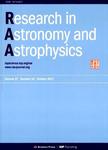Recovering 3D structural properties of galaxies from SDSS-like photometry
Recovering 3D structural properties of galaxies from SDSS-like photometry作者机构:Tartu Observatory Institute of PhysicsUniversity of Tartu
出 版 物:《Research in Astronomy and Astrophysics》 (天文和天体物理学研究(英文版))
年 卷 期:2015年第15卷第10期
页 面:1613-1628页
核心收录:
学科分类:0709[理学-地质学] 07[理学] 0708[理学-地球物理学] 070401[理学-天体物理] 0704[理学-天文学] 0825[工学-航空宇航科学与技术]
基 金:supported by the Estonian Science Foundationprojects IUT26-2 and IUT40-2 support by the Centre of Excellence of Dark Matter in(Astro)particle Physics and Cosmology(TK120) Funding for SDSS-Ⅲ has been provided by the Alfred P.Sloan Foundation the Participating Institutions the National Science Foundation the U.S.Department of Energy Office of Science
主 题:methods: numerical galaxies: general galaxies: photometry galaxies: structure
摘 要:Because of the 3D nature of galaxies, an algorithm for constructing spatial density distribution models of galaxies on the basis of galaxy images has many advan- tages over approximations of the surface density distribution. We present a method for deriving the spatial structure and overall parameters of galaxies from images and estimate its accuracy and derived parameter degeneracies on a sample of idealised model galaxies. The test galaxies consist component with varying proportions and of a disc-like component and a spheroidal properties. Both components are assumed to be axially symmetric and coplanar. We simulate these test galaxies as if they had been observed in the SDSS project through ugriz filters, thus gaining a set of realis- tically imperfect images of galaxies with known intrinsic properties. These artificial SDSS galaxies were thereafter remodelled by approximating the surface brightness distribution with a 2D projection of a bulge+disc spatial distribution model and the restored parameters were compared to the initial ones. Down to the r-band limiting magnitude of 18, errors in the restored integral luminosities and colour indices re- main within 0.05 mag and errors in the luminosities of individual components within 0.2 mag. Accuracy of the restored bulge-to-disc luminosity ratio (B/D) is within 40% in most cases, and becomes worse for galaxies with low B/D, but the general balance between bulges and discs is not shifted systematically. Assuming that the intrinsic disc axial ratio is ≤ 0.3, then the inclination angles can be estimated with errors 〈 5° for most of the galaxies with B/D 〈 2 and with errors 〈 15° up to B/D = 6. Errors in the recovered sizes of the galactic components are below 10% in most cases. The axial ratios and the shape parameter N of Einasto's distribution (similar to the Sersic index) are relatively inaccurate, but can provide statistical estimates for large samples. In general, models of disc components are more accurate than



